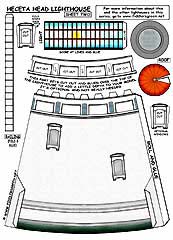


Heceta Head, OR - $$4.95
The bold promontory known as Heceta Head carries the name of Portuguese explorer Don Bruno de Heceta, who sailed the Pacific Northwest coast in 1775 to claim new territory for Spain. Ultimately, though, it would be the United States who took possession of much of the vast territory. By the 1850s, the federal government had begun to establish a series of welcoming beacons along its shores to light the way for seafaring mariners.
Heceta Head Light House(1894)


The bold promontory known as Heceta Head carries the name of Portuguese explorer Don Bruno de Heceta, who sailed the Pacific Northwest coast in 1775 to claim new territory for Spain. Ultimately, though, it would be the United States who took possession of much of the vast territory. By the 1850s, the federal government had begun to establish a series of welcoming beacons along its shores to light the way for seafaring mariners.
Heceta Head Light House(1894)

As the final decade of the 19th century approached, however, no sentinel brightened the 90-mile void between Yaquina Head and Cape Arago. An earlier light had stood at the mouth of the Umpqua River, but it lasted only six years before being tumbled in a rampaging flood. In 1889, the Lighthouse Board unveiled plans to replace the Umpqua tower and construct a major seacoast light at Heceta Head.
In 1893, workers erected a stuccoed brick lighthouse, a pair of oil houses, plus a head keeper's dwelling and an adjoining duplex for two assistants. Early the next year, crews fitted the 56-foot tower with a giant, first-order Fresnel lens, which focused a flashing white light 205 feet above the Pacific. The new station commenced operating on 30 March 1894.
In an economic move, the Coast Guard automated the station in 1963, sending Keeper Oswald Allick into retirement. The US Forest Service acquired all but the two acres immediately surrounding the lighthouse and outbuildings.
After years of neglect, the keeper's house underwent a four-year restoration during the early 1980s, returning it to its original appearance. Afterward, the property reopened as a year-round bed and breakfast. The lighthouse likewise received a major facelift in the early 1990s, and is open periodically during the summertime.
Viewing spot: On site; requires an 0. 35-mi walk via a gravel path.
Directions: Near Milepost 173, US 101, tUm west onto the entrance road (sign) to the Heceta Head Lighthouse State Scenic Viewpoint (and Devil's Elbow Beach) parking area (day-use fee). From here, an unpaved walking trail leads north and west 0.35 mi to the lighthouse. Hotes: The lighthouse is open for tours: daily, 11-5, Mem Day thru Sep, Fri-Sun, noon-4, mid-Mar thru Mem Day and during Oct The grounds are open daily, sunrise-sunset, all year The keeper's house is open for tours daily noon-5 (summer).
 One
of the most photographed lighthouses on the Oregon Coast, Heceta
Head Lighthouse with its 56-foot tower is located on a headland
in a postcard perfect setting. The lighthouse and its rotating
light are a familiar landmark on the Central Coast and when the
light was turned off the locals were very upset.
One
of the most photographed lighthouses on the Oregon Coast, Heceta
Head Lighthouse with its 56-foot tower is located on a headland
in a postcard perfect setting. The lighthouse and its rotating
light are a familiar landmark on the Central Coast and when the
light was turned off the locals were very upset. The main problem was that the cast iron flooring of the lantern room, which supported the first order Fresnel lens that weighs more than a ton, was no longer level. Water had caused rusting, which had heaved the metal causing the lens mechanism to tilt. If the rotating lens had not been stopped, the result would've been catastrophic failure, according to Nicholus Johnston, chief machinists mate from North Carolina and a Fresnel-lens expert.
Johnston had been part of an inspection team that recommended the light be shut down in June 2000. It's the first time in 106 years for the light not to be working except for a temporary shutdown in 1961 when electric cables were cut due to a mudslide.
The repairs involved disassembling the classical lens made up of more than 600 prisms, leveling and shoring up the metal platform that forms the floor of the lantern room, and sending the large metal parts of the gear mechanism to be refurbished. The prisms were labeled, packed in wooden crates, and lowered carefully out of the lighthouse.





